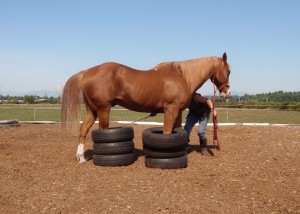-
Help continued:
- Always give your horse enough time to find a solution himself: Any solution, whether partial (proceeding on the right path) or even offering something unexpected. All you ask for in the beginning is that he tackles the task somehow, instead of trying to evade the difficulty by fleeing. At the start it is great if he agrees to get involved in your proposals at all – even if he misunderstands them! A deep sigh, licking and chewing will tell you that he now has found something… he is learning to learn! Without a feeling of success he would not have any fun – he needs to feel clever!
|
|
-
Helfen fortgesetzt:
- Geben Sie dem Pferd genug Zeit selbst eine Lösung zu finden: Irgendeine Lösung, egal ob partiell (aber auf dem richtigen Pfad) oder sogar etwas ganz Unerwartetes. Anfangs verlangt man nur, daß es sich irgendwie mit der Aufgabe auseinandersetzt, anstatt sich durch Flucht der ganzen Schwierigkeit zu entziehen. Es ist ja doch nett von ihm, daß es sich überhaupt auf Ihre Vorschläge einläßt – sogar wenn es sie mißversteht! Ein tiefer Seufzer und zufriedenes Kauen zeigt Ihnen, daß es etwas herausgefunden hat… Ihr Pferd ist dabei das Lernen zu lernen! Ohne ein Erfolgserlebnis hätte es keinen Spaß daran – es muß sich clever fühlen können!
|
- Beau certainly does not lack self-confidence! With my guidance he will step into any trap. He trusts my help – and knows that I will also “free” him again! This is advanced playing – not for a horse that is still anxious or clearly insecure. The end goal of our games is always that our friends trust us in any situation – that is what makes our horses happy and safe!
- If you get confused or over-challenged – stop! Don’t confuse your horse in turn, just because you are not organised. This can easily happen when you first grapple with a lot of equipment such as three ropes and a whip in your hand in our group games. Or all of a sudden the “cloverleaf pattern” eludes you… Give yourself time and patience too.
- When your horse feels over-challenged, he will get frustrated, de-motivated, or even “retreat” from you totally. King was once so confused by a befuddled student’s “aids” that he laid down and played dead – he closed his eyes and clearly said: “I can’t handle this any more!”
- Once your good relationship and trust has been established, your horse will actually actively ask for your help when needed instead of panicking. When my horses get tangled up, they tug on the rope, look at me and wait for my “service”. When Peter once got trapped under a fence while rolling, he stayed still on command and let me free him. Nobody panics. Nice !! Safe!
Continue in part 19 with the beginning of the third Chapter:
How to motivate your horse!
|
|
- Beau hat jede Menge Selbstvertrauen! Unter meiner Anleitung tritt er in jede Falle. Er vertraut auf meine Hilfe – und weiß, daß ich ihm auch wieder heraus helfen werde! Das ist fortgeschritten – nichts für ein Pferd, das noch ängstlich oder panisch ist. Das Endziel unserer Spiele ist immer, daß Ihr Freund Ihnen in jeder Situation vertraut – das ist es, was Ihr Pferd glücklich und sicher macht!
- Wenn Sie sich überfordert fühlen oder sich verheddern – Stopp! Verwirren Sie dann nicht Ihr Pferd ebenfalls, weil Sie die Sache nicht im Griff haben. Und das kommt anfangs natürlich auch vor. Erlauben Sie sich auch selbst Zeit und vergessen Sie nicht, daß wir spielen.
- Wenn sich Ihr Pferd überfordert fühlt, wird es frustriert, de-motiviert, und zieht sich von Ihnen zurück. Unser hyper-sensibler King wurde einmal durch konfuse Hilfen einer Schülerin so verwirrt, daß er sich hinlegte, den Kopf weg drehte und die Augen schloß. Er spielte „tot“ – und sagte damit eindeutig „ich kann das nicht mehr aushalten!“
- Wenn aber einmal ein gutes Vertrauensverhältnis besteht, wird ein Pferd sogar aktiv um Ihre Hilfe bitten, anstatt in Panik zu verfallen. Wenn meine Pferde sich im Stick verheddern, zupfen sie höflich und warten auf meinen „Service“. Auch als Peter sich beim Wälzen einmal im Zaun verfing, blieb er brav still liegen und ließ sich befreien. Keine Panik mehr! Angenehm – und sicher!
Lesen Sie im nächsten Teil 19 – Anfang des dritten Kapitels:
Wie man sein Pferd motiviert !
|


